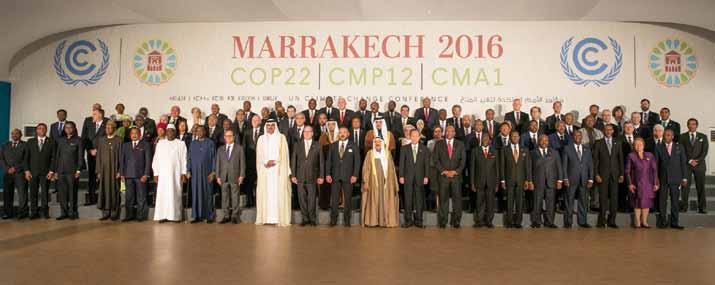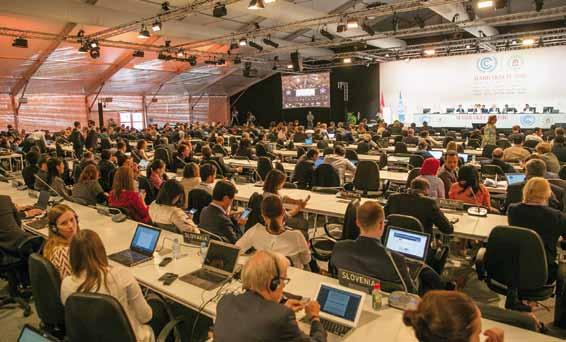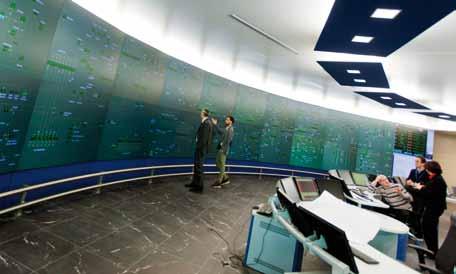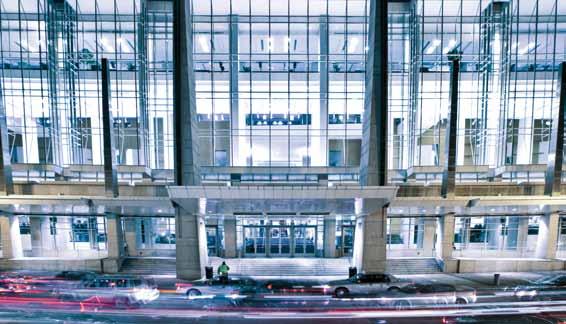
14 minute read
COP 22: as climate change policy gains momentum, the future gets brighter for gas
by IGU
By Alex Forbes
x While attracting less
coverage than COP 21 in Paris, COP 22 was well attended by heads of state, governments and ministers from around the world.
The COP 22 United Nations climate change talks in Marrakech last November passed without fanfare on the scale that greeted the previous year’s talks in Paris – but the context in which they took place was remarkable and their significance for the future of the natural gas industry profound. The industry has long campaigned for a meaningful international climate agreement that would allow gas to assume its rightful place in the global energy mix. In Paris, it was granted that wish and Marrakech was a big step towards implementation.
When the international community hammered out the Paris Climate Change Agreement in December 2015 – setting a target “to limit global warming to well below 2°C and as close to 1.5°C as possible to prevent dangerous tipping points in the climate system” – even the optimists thought
it would take at least a couple of years for the agreement to come into effect.
For that to happen, it had to be ratified by at least 55 countries accounting for at least 55% of global greenhouse-gas (GHG) emissions. That threshold was passed on October 6, 2016, triggering a 30-day countdown. So, just three days before the COP 22 climate talks in Marrakech began, the Paris Climate Change Agreement took effect – “an unexpectedly rapid result”, commented the secretariat of the UN Framework Convention on Climate Change (UNFCCC).
“The Paris Agreement’s ambitious and essential goals are now a live reality for every government,” said Patricia Espinosa, Executive Secretary of the UNFCCC. “From today, everincreasing climate action becomes an accepted responsibility and a central part of the sustainable development plans of all countries.”

This meant that the 22nd Conference of the Parties (COP) to the UNFCCC was the first such conference to take place under the terms of the Paris Agreement and thus played host to the first meeting of the agreement’s governing body, the CMA (which, in the jargon of the UN climate process, stands for the Conference of the Parties to the Convention serving as the meeting of the Parties to the Paris Agreement).
US election
Then, on the second day of the conference, came the result of the presidential election in the United States.
Donald Trump’s victory took many by surprise, casting a shadow over the climate talks because of the negative statements he has made about climate change and the Paris Agreement. He once described climate change as a “hoax” and said on the campaign trail that he would withdraw the US from the Paris Agreement. The IGU delegation that attended the talks later commented: “Spirits were noticeably dampened by the results of the US election.”
At the time of writing, it remains to be seen how US climate change policy will evolve under President Trump, but such was the positive momentum at the Marrakech talks that they ended on an upbeat note despite worries about what the US might do next.
Yet another significant contextual dimension for the Marrakech talks, and for the natural gas industry, was the publication a couple of days before the talks concluded of the latest World Energy Outlook (WEO) from the International Energy Agency (IEA).
Arguably, the most influential of the longterm energy outlooks, the 2016 edition of the WEO was notable for projections taking account of the almost 200 climate-policy pledges, known as Nationally Determined Contributions (NDCs), that countries had made as part of the Paris Agreement process. The importance of these NDCs cannot be overstated as it is the policies set out in these pledges that are the foundation for meeting the targets in the Paris Agreement.
Time for “concerted, collective endeavour”
In his foreword to the WEO, IEA’s Executive Director Fatih Birol writes: “A new sense of direction pervades the international climate and energy community… The commitments made in Paris are national but the determination to realise change is shared. The outlook for global energy changes in consequence.
“Our new projections reflect this. The NDCs… are now at the heart of our New

c Patricia Espinosa,
Executive Secretary of the UNFCCC, spoke of everincreasing climate action as central to future development planning.
x John Kerry, then US
Secretary of State, in his address to participants and press, underlined America’s commitment to climate action. The election of Donald Trump may see a re-evaluation of this commitment.
x Figure 1. Policies Scenario [NPS]. The prospective changes to the global energy scene are not yet enough to deliver the necessary containment of CO 2 emissions. But we are making progress. No one believes that COP 21 was the end of the story. But it is, perhaps, the ‘end of the beginning’ – the moment when the world put in place a suitable framework for concerted, collective endeavour.”
Figure 1 shows what the IEA projects for natural gas in its three main scenarios. In the base-case scenario, the NPS, demand continues to climb to 2040 by an average of 1.5% per year. In the 450 Scenario, a case consistent with a 50% chance meeting the Paris target of keeping global warming within 2°C of preindustrial times, demand rises until the late 2020s and then plateaus, reflecting the flattening off of global primary energy demand growth in that scenario; in contrast, oil demand declines for most of the projection period and demand for coal falls steeply over the whole projection period.
In a statement welcoming the positive outlook for gas in the WEO, IGU President David Carroll said: “While an anticipated
World natural gas demand by scenario
6000
5000
4000
3000
2000
1000
0 32874 36526 40179
To Date (remove from legend) 450 Scenario
Source: IEA World Energy Outlook
43831 47484 51136
New Policies Scenario Current Policies Scenario
growth rate of 1.5% is lower than the 2.5% observed over the past 25 years, natural gas continues to be seen as the fastest growing among the fossil fuels and is expected to increase its share in global primary energy demand from 21% today to 24% in 2040.
“What is more, also in the 450 Scenario, which is even more aspiring in terms of climate change policies, natural gas is acknowledged as a relatively clean and flexible fuel.”
Carroll went on to say that the IGU fully supports the transition to a lower-carbon economy consistent with the outcome of COP 21 and recognises the large part that renewable energy will play in that transition: “IGU welcomes IEA’s view that natural gas is ‘especially advantageous to the transition if it can help smooth the integration of renewables into power systems along the way’.”
Implementation and action
So what did the COP 22 Marrakech talks achieve? Among the bewildering array of announcements about initiatives, promises and commitments on the part of the UNFCCC, governments, businesses and NGOs, one crucial outcome stands out: agreement to set a “fasttrack date” of 2018 to complete the rule book, or operational manual, of the Paris Agreement. In other words, to formulate the rules and processes needed to realise its ambition and measure progress towards it.
“The agreement calls for a significant boost of transparency of action, including for measuring and accounting emissions reductions, the provision of climate finance, and technology development and transfer,” said the UNFCCC. “It also includes work to design the adaptation communications, which is the primary vehicle under the Paris Agreement to share individual adaptation efforts and support needs.”
The prominence of “adaptation” in the climate talks, both in Paris and Marrakech, is an acknowledgement that climate change
is already under way and that mitigation alone is no longer a realistic response. So developing nations, especially the poorer and most vulnerable ones, will need assistance – financial and in capacity-building – not just to contain their GHG emissions but also to strengthen their ability to adapt to the effects of climate change.
The UNFCCC’s Espinosa commented that: “COP 22 has been what it needed to be: a COP of action that has accelerated progress under the Paris Agreement across finance, new initiatives, ambition and solidarity between nations and across continents.”
Mind the “gap”
The need for all involved in addressing climate change to raise ambition was captured in the Marrakech Action Proclamation that emerged as the culmination of the COP 22 talks: “We, heads of state, government and delegations… call for urgently raising ambition and strengthening cooperation among ourselves to close the gap between current emissions trajectories and the pathway needed to meet the long-term temperature goals of the Paris Agreement.”

That “gap” was quantified in the run-up to the COP 22 talks in a report released by the UN Environment Programme (UNEP), warning that even with the climate-action pledges that have already been made in the NDCs, the world is on track for warming of 2.9-3.4°C by the end of this century.
In its annual Emissions Gap Report, UNEP said: “Scientists agree that limiting global warming to under 2°C this century (compared to pre-industrial levels) will reduce the likelihood of more-intense storms, longer droughts, sea-level rise and other severe climate impacts. Even hitting the lower target of 1.5°C will only reduce, rather than eliminate, impacts… Waiting to increase ambition would likely lose the chance to meet the 1.5°C target, increase carbon-intensive technology lock-in and raise the cost of a global transition to low emissions.”
The pressure is therefore on for all the countries that have submitted NDCs to revisit them periodically and to ratchet up climate action to cut predicted 2030 emissions by “a further 25%”, says UNEP – from 54-56 gigatonnes (Gt), as currently projected, to 42Gt.
c Consultations on the
preparations for the entry into force of the Paris Agreement and CMA 1 took place throughout the conference.
“If we don’t start taking additional action now, beginning with the upcoming climate meeting in Marrakech, we will grieve over the avoidable human tragedy,” said UNEP head Erik Solheim. “The growing numbers of climate refugees hit by hunger, poverty, illness and conflict will be a constant reminder of our failure to deliver. The science shows that we need to move much faster.”
Under the terms of the Paris Agreement, countries have agreed to submit updated NDCs every five years. The agreement also establishes the principle that “future action plans will be no less ambitious than existing ones”, says the UNFCCC. A global stocktake is to be carried out every five years “to assess the collective progress towards the goals of the agreement”, with the first due in 2023.
Implications for gas
Even as they stand, the pledges in many of the NDCs are ambitious and many countries will struggle to meet them unless natural gas takes a significant share of the energy mix. A paper entitled “The way forward after COP 21: why natural gas is the key to a low-carbon world” – published last October by the IGU Strategy Committee and available on the IGU website – explains why.
To limit global warming to within 2°C, we need to keep cumulative GHG emissions below a level that has become known as the “carbon budget”. There is widespread agreement that for the foreseeable future it will not be possible to meet humankind’s energy needs solely with renewables. So, argues the paper, “it becomes absolutely vital to reduce emissions from fossil fuel use as quickly as possible” to make the most of this carbon budget. It adds: “All major energy scenarios from independent organisations come to the conclusion that this is best achieved by replacing coal – and to some extent oil – by natural gas on as large a scale as possible.”
The rationale behind this is largely to do with the chemistry of fossil fuels and the amount of hydrogen that each molecule contains. When a hydrocarbon molecule is burnt, the carbon it contains reacts with oxygen to form CO 2 while the hydrogen reacts with oxygen to form harmless water. Methane has four hydrogen atoms per atom of carbon, oil roughly two and coal none. So in a power station, gas emits much less CO 2 than coal per unit of electricity generated. (It helps that gasfired power stations are generally more thermally efficient than coal-fired ones.)
The net result is that unless carbon capture and storage becomes commercially viable for coal-fired electricity generation – and it shows little sign of doing so at the moment – it makes sense to use gas where it is economic to do so.
As governments gear up to implement lowcarbon energy agendas, a number of proposed policies will improve the economics of gas, especially versus its main competitor in electricity generation: coal. One such policy is carbon pricing, which is being heavily promoted by the natural gas industry. One of its most vocal supporters among gas industry leaders is Total CEO Patrick Pouyanné: “Around 40 countries and regions have already introduced a carbon-pricing mechanism or are considering doing so,” he says. “Steering investment in the private sector is vital if we want to keep global warming under 2°C. Putting a price on CO 2 is the most efficient financial mechanism to change the rules of the game quickly…
“The main priority is to reduce the use of coal which generates more emissions than any other type of energy, and to switch to gas and renewables for power generation. A carbon price of $30-40/tonne would make this possible.”
Alex Forbes is an independent journalist and consultant who has been reporting on energy developments and analysing trends for over three decades.
A European leader in the construction and integrated management of natural gas infrastructure, Snam is the owner, operator and developer of Europe’s largest, most accessible pipeline network (approximately 32,500 km long), one of the largest storage infrastructures (with a capacity of 16.5 bcm) and the first LNG terminal built in Italy. With its 3,000 people, Snam is active in natural gas transportation, storage and regasification. It operates, through associated companies, in Austria (TAG, GCA), France (TIGF), the United Kingdom (Interconnector UK) and is one of the leading shareholders of the TAP pipeline.
Having demerged its distribution unit in late 2016, the company has taken up the challenge set by a rapidly evolving energy landscape and embraced it to enhance its international footprint. Snam’s investments aim at supporting the development of Italian infrastructure and their seamless interconnection with other European infrastructures, strengthening the security, flexibility and liquidity of the overall EU gas system and enhancing supply diversification. On a larger scale, the company leverages its international assets to facilitate the Energy Union network integration, enabling a greater flow of energy between countries thus promoting competition and allowing gas to preserve a fundamental role in the energy mix. As a leading player on Europe’s gas infrastructure playing field, Snam has a pivotal role in supporting policymakers in crucial processes such as energy market integration and the achievement of a lower-carbon economy in Europe by affirming natural gas as the fuel of choice for an immediate and efficient sustainable energy mix in today’s and tomorrow’s environment.
In Italy, the company’s investments – approximately €1 billion per year – focus on strengthening the gas transportation network and creating further storage capacity, enabling the completion of reverse flow capacity towards other European countries and including new gas flows coming from the Caspian region through the TAP, in which Snam holds a 20% interest. Recent international developments include the acquisition of a 49% stake in Gas Connect Austria (GCA) from OMV in partnership with Allianz, which enabled the further enhancement of Snam’s position in a strategic market for import transit towards Europe and the core of a regional consolidation, beneficial to the overall southeastern market development. Snam has had a presence in Austria for more than 40 years, where it has developed – in a longstanding partnership with OMV and lately GCA – the TAG (Trans-Austria-Gasleitung) pipeline, the backbone of the Austrian gas infrastructure, currently holding an 84.47% co-controlling stake jointly with GCA.
Broadening its range of activities, Snam is developing new services and technologies to support emerging uses of natural gas and promote its role in de-carbonising industries and transport. Last year, the company

joined efforts with two industry leaders in Italy, FCA and IVECO, to foster the development of compressed natural gas (CNG) as a fuel for road vehicles, in line with the European Directive on Alternative Fuels for Sustainable Mobility. Methane fuelling for cars, trucks and buses has in fact significant environmental benefits as it ensures a
relevant reduction of polluting emissions such as CO₂, NO x (nitrogen oxides) and particulate matter. Along with CNG for road vehicles, Snam is closely following the development of small-scale LNG services for road and maritime transport, which has a significantly lower environmental footprint compared with traditional oil products, and the development of biomethane, a fully renewable and programmable energy source obtained from agricultural and agroindustrial biomasses, able to give a boost to the energy transition towards an economic model based on a sustainable and circular utilisation of resources.
c Gas compressor station, Malborghetto, Italy.
x Snam Rete Gas’ San Donato Milanese dispatching centre manages and continuously monitors the gas transportation system.











